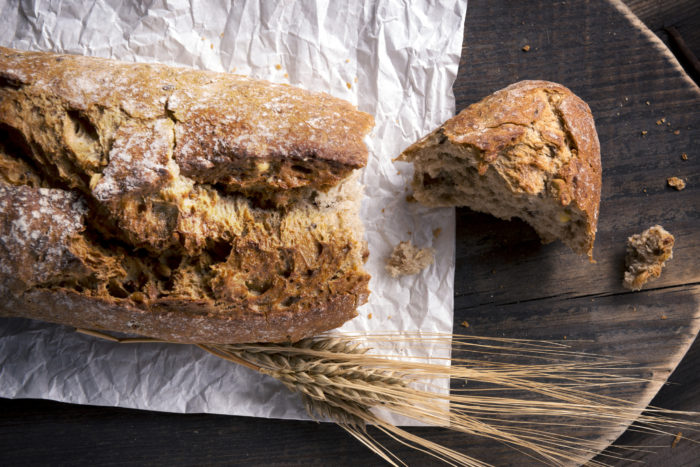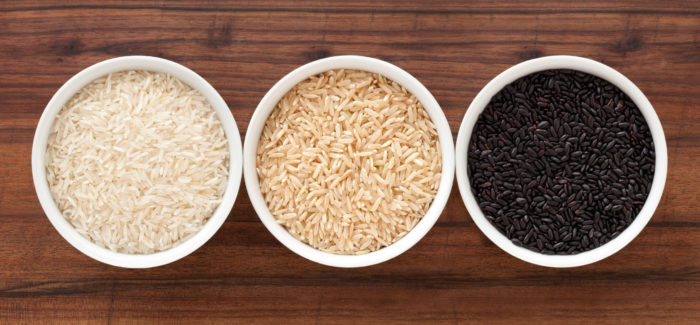It’s no secret that the Paleo community seems to have a vendetta against grains.
Many Paleo advocates preach that grain consumption is the root of poor health and chronic disease. The war against grains leads many to believe that if they eat any grains they will surely become fat and sick.
But for most healthy people, this isn’t true.
And avoiding grains like the plague may actually make it harder to accomplish your health goals.
Keep reading to learn my perspective on grains, as well as which grains are the best to include in a healthy, whole foods diet.
Like what you’re reading? Get updates on all my new content by joining my newsletter!
Are grains really the root of all disease?
The major issue that most Paleo advocates have against grains is the high levels of phytates and lectins they contain.
These anti-nutrient compounds bind to minerals like calcium, iron, zinc and magnesium preventing optimal absorption from the food we eat. Lectins and phytates can also be damaging to your GI tract, which could exacerbate a leaky gut or autoimmune condition.
Many grains also contain the infamous protein gluten. The Paleo community has shined a light on how this potentially problematic protein can cause issues for people beyond just those with celiac disease.
Eating gluten causes the secretion of a protein called zonulin, which regulates the tight junctions of our intestinal lining. When these tight junctions are open, bacteria, toxins, and food particles can slip through the gut barrier. These intruding particles triggers our immune system, which can lead to a systemic inflammatory response.
Many individuals with autoimmune problems feel significantly better when they eliminate gluten from their diet, primarily because it helps calm down the inflammatory immune process in the gut.
These are the key reasons the Paleo community recommends eliminating all grains from our diets, in particular gluten containing grains like wheat, barley, and rye.
And while the Paleo argument does make some good points against grains, is it really necessary to avoid grains like the plague?
Is indulging in a piece of cake at a wedding or having a cup of oatmeal at breakfast going to be a detriment to your health, no matter who you are?
Learn how to create a diet free from FEAR with my free eBook!
HOW TO INCLUDE GRAINS IN A HEALTHY DIET
While some individuals may need to avoid all grains to maximize their health potential, most people can incorporate some amount of grains into a diverse whole foods diet.
Keep in mind that the 6-11 servings a day recommendation by the USDA is not necessary or ideal. Many conventional nutritionists promote this high grain consumption, even warning Paleo followers that their grain avoidance will lead to nutrient deficiencies.
These pro-grain arguments are completely unfounded. A diverse Paleo diet that is free of grains can certainly meet all the nutritional needs to live a long and healthy life. My concern is about the suggestion that all people should avoid all grains for optimal health, which isn’t true either.
For most people there is a middle ground somewhere between complete avoidance and multiple servings of whole grains at each meal.
Finding the grains that work best for your body can require some experimentation, though. Certain grains seem to be better tolerated than others.
Here’s a breakdown of the most popular grains to consider including – or avoiding – your diet depending on your health needs and goals.

Wheat
Wheat, especially modern wheat, is probably the most problematic of all the grains. Those who promote whole wheat consumption argue that cultures have been eating wheat for centuries without issue, which is true. The problem is that the wheat we ate even 50 years ago is not the wheat we eat today.
Modern wheat found in our processed foods is a hybridized and crossbred version of the ancient Einkorn wheat that our ancestors ate. This Frankenwheat is a shorter and stocker grain compared to Einkorn wheat.
Dr. Mark Hyman, best-selling author and functional medical doctor, describes the three major reasons why Frankenwheat causes so much trouble.
He says the “super gluten” found in wheat contains twice as many chromosomes and a larger variety of proteins than ancient wheat. This genetic change makes modern wheat much harder to break down and digest, which can lead to immune reactions and inflammation in individuals who are sensitive to gluten.
Higher levels of a “super starch” called amylopectin A lead to higher blood sugar spikes when compared the same amount carbs from table sugar. These blood sugar spikes can lead to insulin resistance in the context of a calorie surplus, which is easy to get into when consuming large amounts of processed wheat products.
Modern wheat may have an addictive effect as well. According to Dr. Hyman, when wheat is digested, “exorphins” are absorbed into the blood stream and attach to the opiate receptors in the brain. Similar to endorphins that are released during exercise, exorphins create a “high” feeling, giving wheat the potential to be addictive, and stimulate overconsumption.
In his book Perfect Health Diet, Paul Jaminet also highlights another potential problem with wheat—wheat germ agglutination. WGA is a lectin that has been linked to leptin resistance, gut inflammation, autoimmunity, vitamin D deficiency and even lower IQ. Jaminet also points out that wheat appears to be the most toxic food in the China Study with a 67% correlation with heart disease.
With all this in mind, conventional wheat is probably best to be avoided, and limited to the occasional treat for those who do not have an autoimmune or leaky gut issue.
If you do choose to eat wheat regularly, look for organic and ancient varieties like Einkorn wheat, as well as soaked/sprouted sourdough type products. If you have an autoimmune disease, avoiding wheat and gluten is a good idea.
Oats
Oats have a bad reputation in the Paleo community but in scientific literature, oats seem to show positive health benefits.
Oats appeared to produce a healthier blood lipid profile compared to wheat in a study of obese men. Another study showed that oats can help lower cholesterol levels. The benefits of oats are most likely due to the high soluble fiber content that provide food for our gut bacteria.
In fact, beta glucans, the fermentable fiber in oats, produces more butyrate than other prebiotic fibers including inulin and guar gum. Butyrate is the preferred fuel source for our intestinal cells and helps maintain the integrity of the gut lining. This means oats could actually benefit our GI health rather than harm it.
The good news about oats is that even individuals that can’t tolerate gluten can buy certified gluten free oats and still get the benefits of the soluble fibers.
Would you like to save this post?
Your email address is 100% safe and will never be sent spam.
I often recommend oats as a great way to bump up my clients’ carbohydrate intake in the morning if they are trying to consume a higher carb diet to meet their health goals. Soaking oats overnight tend to make them easier to digest, and pairing them with a good portion of protein and some fat can prevent the common blood sugar issues that many people experience when eating oats on their own.
Stick to whole grain oats, such as steel cut or rolled oats, and avoid the “quick oats” varieties which tend to have more of a negative impact on blood sugar control due to their high glycemic index.
Rye and Barley
Rye is unique because it has the highest phytase content of any grain. Phytase is the enzyme that breaks down phytic acid, which makes the grain easier to digest and absorb. A study on mice found that wheat promoted obesity while rye consumption reduced adiposity and weight while improving insulin sensitivity.
This means rye is potentially a better option than wheat, especially when it is produced as a sourdough. (Soaking rye allows the phytase to do its job breaking down phytic acid.) This applies only to people who tolerate moderate amounts of gluten consumption.
Barley is another gluten-containing grain that gets a lot of positive press from the whole grain movement. However, one study showed that the fiber from barley doesn’t appear to have the same metabolic and lipid benefits that oats do. This means oats and rye appear to be the best options of the gluten containing grains, and barley may be less beneficial.
While some people may need to avoid all gluten-containing grains, most people can usually tolerate the occasional consumption of rye, barley and oats. These grains can increase our dietary variety, provide extra fiber to feed our gut flora, and increase our dense carbohydrate options in a healthy whole foods diet.
Rice
Rice is one of the more ‘acceptable’ grains in the Paleo community because it’s gluten-free, and white rice contains little to no anti-nutrients. (#teamwhiterice) There are many varieties of rice on the market, including jasmine or basmati rice, brown rice, and even black rice.
Most conventional nutrition sources promote brown rice over white rice as the best option because it’s lower on the glycemic index, higher in fiber, and contains more nutrients than white rice.
However, brown rice has high amounts of the anti nutrients phytates and lectins, which prevent us from digesting the vitamins and minerals found in brown rice. Almost all of the fiber in brown rice is insoluble which doesn’t feed the beneficial bacteria in your gut. Brown rice also may contain significant amounts of arsenic, making it a questionable food to eat as a dietary staple.
On the other hand, cooked white rice is a low toxin food since it is low in phytates and lectins. When cooked and cooled (then re-heated), white rice develops resistant starch which can feed our gut flora. White rice is one of the easiest grains to digest, and many individuals tolerate it better than brown rice.
People with blood sugar issues, gut infections, or autoimmunity may not tolerate a large amount of white rice in their diet. But for most of us, white rice is an awesome way to get safe and easy-to-digest carbs in our diet to support our activity levels and health goals. It also opens up a huge amount of variety in our diet, particularly if we’re eating out.
White rice gets a big thumbs-up in my book when it comes to grains!
Millet
Millet, like rice, is another gluten-free option that may seem like a perfect swap for gluten-containing grains. However, millet is one of the most goitrogenic foods in the world.
Goitrogens are compounds in foods that inhibit thyroid hormone production. Eating lots of millet could potentially induce hypothyroidism or even a goiter if enough was eaten on a regular basis, especially if iodine intake was low.
Individuals struggling with hypothyroidism may want to avoid millet for the most part. But, if you don’t have thyroid problems, eating millet in moderation is likely okay. (And goitrogens in general are not something you need to worry about in reasonable quantities.)

Quinoa, Buckwheat and Amaranth
Quinoa, buckwheat and amaranth are popular gluten-free “pseudo-grains” that most people tend to tolerate well. Quinoa and buckwheat are a good source of fiber and higher in protein than most grains. They are also high in phytonutrients and flavonoids that have the potential to reduce the risk of certain chronic diseases, including cardiovascular disease and diabetes.
Amaranth – a lesser known pseudo-grain – is found in a lot of gluten-free products. Amaranth consumption may reduce the risk of cardiovascular disease, hypertension and cancer.
My favorite of these pseudo-grains is buckwheat. Buckwheat isn’t even a grain, despite having the word “wheat” in it’s name. Botanically speaking, it’s a fruit. And buckwheat is one of the easiest starches for my clients to digest, making it a great way to bump up carb intake on a restricted diet.
I personally love hot buckwheat cereal and 100% buckwheat noodles as a delicious carb option to have on a weekly basis.
Properly preparing grains
The Paleo community seems to completely throw out grains without a second thought. This ignores the fact that properly preparing grains eliminate most of the problematic phytates and lectins and makes them much easier to digest.
Sprouting, soaking and fermenting grains before consumption can drastically reduce toxins in grains increasing their digestibility and nutrient availability. The Weston A. Price Foundation has some great resources on how to properly prepare grains.
You don’t need to give up grains if you tolerate them, but you should be aware of the best strategies to reduce the toxicity especially if you’re dealing with a chronic health issue.
With most of these anti-nutrient compounds reduced through the soaking and sprouting process, many people can enjoy these foods without problems, and they can be a health-promoting addition to a whole foods diet.

Who should avoid grains?
As I’ve mentioned throughout this post, there are certain individuals that may need to avoid grains. If you have digestive issues or an autoimmune disease, I often advise temporary removal of all grains – gluten especially – in order to heal. But, don’t be afraid to try and experiment once you have healed your gut.
Some individuals with autoimmunity may need to remain grain-free or gluten-free permanently to feel their best, while others can thrive on a more diverse, grain inclusive diet.
For example, thyroid disorders are highly associated with gluten sensitivity, so if you have Hashimoto’s disease it is probably a good idea to steer clear of gluten-containing grains. But gluten-free grains may work just fine.
It’s probably best to start with white rice or buckwheat when re-introducing grains since they have the lowest toxicity and the greatest tolerance that I’ve seen in my clients. If white rice and buckwheat are tolerated, trying some additional gluten-free grains or pseudo-grains is the best next step. Finally, gluten-containing grains can be reintroduced in order to determine if gluten is an actual issue for you or not.
Keep in mind, it’s crucial to try each grain one at a time, so you can detect how your body is tolerating each one. More than likely, you’ll discover that you tolerate some grains and not others.
Stick with the grains that work with your body, while cutting the ones that don’t. Even those that you don’t tolerate well might be able to be enjoyed occasionally, though.
Bottom Line
Grains are not something to fear! When prepared properly and eaten in moderation, they can even be health-promoting for many people. Wheat seems to be the most problematic grain and is probably best to be avoided for the large majority of people. But, most people can include many types of grains in their diet without issue.
Did this article teach you something new about grains? If so, please SHARE it with others interested in learning more about this topic and leave your comments below.
Click here to receive more great content like this delivered directly to your inbox!
This post may contain affiliate links. If you click on a link and make a purchase, I may receive a small commission.


+ show Comments
- Hide Comments
add a comment